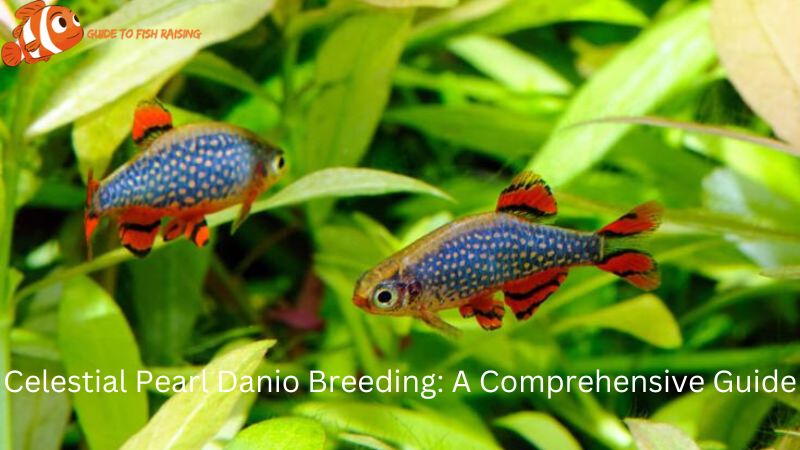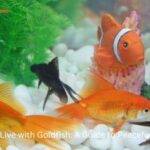Celestial Pearl Danio (Danio margaritatus), also known as the Galaxy Rasbora, is a popular and captivating species of freshwater fish renowned for its vibrant coloration and small size. Native to Myanmar, these fish are highly prized by aquarists and breeders for their stunning appearance and ease of care. This article Guide to Fish Raising provides a comprehensive guide on Celestial Pearl Danio Breeding, including their biology, habitat requirements, breeding setup, and care for the fry.
Table of contents
ToggleUnderstanding Celestial Pearl Danio
Biological Overview
Celestial Pearl Danios are small, peaceful fish that typically reach a maximum length of about 1.2 inches (3 cm). They are characterized by their iridescent blue and gold spots, which resemble a starry night sky, hence their common name. These fish have a relatively short lifespan of 2-3 years but are known for their vibrant colors and lively behavior.
Natural Habitat
In the wild, Celestial Pearl Danios are found in shallow, slow-moving streams and ponds in Myanmar. They inhabit densely vegetated areas, which provide both food and shelter. This natural habitat plays a crucial role in their behavior and breeding patterns.
Housing Celestial Pearl Danio
Tank Requirements
Celestial Pearl Danios are relatively small and adaptable, but providing them with an appropriate environment is key to their health and successful breeding. Here’s what you need to know about housing them:
- Tank Size: A minimum of 10 gallons (38 liters) is recommended for a small group of Celestial Pearl Danios. However, for breeding purposes, a separate breeding tank of 5-10 gallons (19-38 liters) is ideal.
- Substrate: Use a fine substrate or a bare bottom in the breeding tank to make it easier to collect eggs.
- Plants: Provide a densely planted tank with a variety of live plants. Fine-leaved plants like Java moss or spawning mops are particularly useful, as they serve as ideal egg-laying sites.
Water Conditions
Maintaining optimal water conditions is crucial for the health and breeding success of Celestial Pearl Danios:
- Temperature: 72-78°F (22-26°C) is ideal. Slightly warmer temperatures can stimulate breeding behavior.
- pH Level: Aim for a slightly acidic to neutral pH, between 6.5 and 7.5.
- Hardness: Maintain water hardness between 5 and 15 dGH. Slightly softer water is beneficial during the breeding process.
Filtration and Aeration
- Filtration: A gentle filter is necessary to keep the water clean without creating strong currents that could stress the fish. Sponge filters are a good choice for breeding tanks.
- Aeration: Ensure adequate aeration to maintain oxygen levels, particularly in the breeding tank where water changes and temperature fluctuations can occur.
Preparing for Breeding
Selecting Breeding Pairs
Identifying Males and Females
Sexual dimorphism is subtle in Celestial Pearl Danios, but there are a few indicators that can help identify males and females:
- Males: Generally have more intense coloration, with brighter blue and gold spots. They also have a more streamlined body shape and slightly larger fins.
- Females: Typically appear slightly fuller-bodied, especially when gravid (carrying eggs), and have less vibrant coloration compared to males.
Conditioning Breeding Pairs
Proper conditioning of breeding pairs is essential for successful spawning:
- Diet: Feed the fish a varied diet consisting of high-quality flakes or pellets, supplemented with live or frozen foods such as brine shrimp, daphnia, and bloodworms. This will ensure the fish are in peak condition for breeding.
- Conditioning Period: Condition the fish for 2-3 weeks before introducing them to the breeding tank. This period helps ensure that both males and females are healthy and ready to spawn.
Setting Up the Breeding Tank
Tank Setup
To create an ideal breeding environment:
- Size: A 5-10 gallon (19-38 liters) tank is suitable for breeding Celestial Pearl Danios. This smaller size makes it easier to manage and monitor the breeding process.
- Substrate and Plants: Use a fine substrate or a bare bottom to make it easier to collect eggs. Add plenty of fine-leaved plants like Java moss or spawning mops, where the eggs can adhere.
- Water Conditions: Ensure that the water conditions in the breeding tank match those of the main tank but with slightly softer and more acidic water.
Temperature
Increase the water temperature in the breeding tank to 76-80°F (24-27°C). Warmer temperatures can help trigger spawning behavior and increase the likelihood of successful breeding.
Breeding Process
Spawning Behavior
Celestial Pearl Danios are egg-scatterers, meaning they lay their eggs randomly rather than in a specific location. During spawning:
- Courtship: Males will actively chase females, displaying their vibrant colors and engaging in mating dances.
- Egg Laying: The pair will scatter eggs among the plants or spawning mops. Each spawning session can result in several dozen eggs.
Observing Spawning
- Timing: Spawning typically occurs in the early morning hours. The process may last for a few hours, with multiple spawning events over several days if conditions are ideal.
- Number of Eggs: A single spawning session can yield up to 50-100 eggs. Eggs are small, translucent, and adhere to plants or the substrate.

Egg Care
Removing Adults
After spawning, promptly remove the adult fish from the breeding tank to prevent them from consuming the eggs. Celestial Pearl Danios are known to eat their eggs if left in the tank.
Incubation
- Hatching: Eggs will usually hatch within 24-48 hours, depending on water temperature and conditions.
- Water Quality: Maintain excellent water quality with frequent water changes to ensure the eggs and newly hatched fry develop properly.
Caring for Fry
Hatching and Initial Care
Once the eggs hatch, the fry will initially rely on their yolk sacs for nourishment. Here’s how to care for them:
- Yolk Sac: Fry will absorb the yolk sac within a few days. During this period, they remain in a stationary position and do not need additional food.
- Free Swimming: After the yolk sac is absorbed, fry will begin to swim freely and require external food sources.
Feeding Fry
- First Foods: Start feeding the fry with infusoria or finely crushed powdered foods. As they grow, you can introduce larger foods such as micro-worms, baby brine shrimp, or finely crushed fish flakes.
- Feeding Frequency: Provide small amounts of food multiple times a day to ensure continuous nutrient availability. Monitor the fry closely to ensure they are eating and growing properly.
Growth and Development
- Water Changes: Perform regular water changes to maintain water quality and prevent the buildup of waste products. Frequent changes help keep the environment clean and healthy for the growing fry.
- Tank Maintenance: Keep the tank clean and remove any uneaten food to prevent contamination. Provide additional hiding places as the fry grow to reduce stress.
Common Issues and Solutions
Egg Fungus
Problem: Fungus can sometimes develop on eggs if the water quality is poor or if there are dead eggs in the tank.
Solution: Remove any affected eggs and maintain good water quality with frequent changes. Adding a small amount of antifungal medication can also help if needed.
Fry Survival Rate
Problem: A low survival rate among fry can be due to inadequate food, poor water quality, or aggressive tankmates.
Solution: Ensure the fry have a suitable diet, maintain excellent water quality, and keep the tank free from aggressive fish. Providing ample hiding places and reducing stress will improve survival rates.
Long-Term Care and Raising
Growing Out Fry
As the fry grow, gradually increase the size of their food and monitor their development. Once they reach about 1 inch (2.5 cm) in length, you can start transferring them to a larger tank. This transition allows them to continue growing and developing in a more suitable environment.
Maintaining Health
Regularly check for signs of illness, such as unusual behavior, discoloration, or fin damage. Address any health issues promptly to ensure a healthy population of Celestial Pearl Danios. Regular tank maintenance and a balanced diet are key to preventing disease and promoting overall well-being.
Conclusion
Breeding Celestial Pearl Danios can be a rewarding and enjoyable experience. By understanding their biological needs, setting up a proper breeding environment, and providing excellent care for both the adults and fry, you can successfully breed and raise these beautiful fish. Whether you’re a hobbyist looking to expand your aquarium or a breeder aiming to share these stunning fish with others, following these guidelines will help ensure a successful breeding process and healthy offspring.





